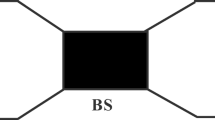Abstract
Unconditional security of the quantum key distribution protocol has been proved, but the practical quantum key distribution system may be attacked by utilizing imperfect state preparation and measurement devices. To improve security of the practical quantum key distribution system, we propose the weak measurement model to monitor the intercept-resend eavesdropping strategy in the quantum channel, where the detector-blinding attack and the wavelength attack can be observed through the quantum bit error rate value in the weak measurement model.




Similar content being viewed by others
References
Bennett, C.H., Brassard, G.: Quantum cryptography: public key distribution and coin tossing. In: Proceedings of IEEE International Conference on Computers, Systems and Signal Processing, Bangalore, India, pp. 175–179. IEEE, New York (1984)
Lo, H.K., Chau, H.F.: Unconditional security of quantum key distribution over arbitrarily long distances. Science 283, 2050 (1999)
Shor, P.W., Preskill, J.: Simple proof of security of the BB84 quantum key distribution protocol. Phys. Rev. Lett. 85, 441 (2000)
Renner, R.: Security of quantum key distribution. Int. J. Quantum Inf. 6(01), 1–127 (2008)
Renner, R., Gisin, N., Kraus, B.: Information-theoretic security proof for quantum-key-distribution protocols. Phys. Rev. A 72, 012332 (2005)
Fuchs, C.A., Gisin, N., Griffiths, R.B., et al.: Optimal eavesdropping in quantum cryptography. I. Information bound and optimal strategy. Phys. Rev. A 56, 1163 (1997)
Li, H.W., Wang, S., Huang, J.Z., et al.: Attacking a practical quantum-key-distribution system with wavelength-dependent beam-splitter and multiwavelength sources. Phys. Rev. A 84(6), 062308 (2011)
Qi, B., Fung, C.H.F., Lo, H.K., Ma, X.: Time-shift attack in practical quantum cryptosystems. Quantum Inf. Comput. 7, 073 (2007)
Lydersen, L., Wiechers, C., Wittmann, C., Elser, D., Skaar, J., Makarov, V.: Hacking commercial quantum cryptography systems by tailored bright illumination. Nat. Photonics 4, p686–689 (2010)
Scarani, V., Bechmann-Pasquinucci, H., Cerf, N.J., et al.: The security of practical quantum key distribution. Rev. Mod. Phys. 81, 1301 (2009)
Huttner, B., Imoto, N., Gisin, N.: Quantum cryptography with coherent states. Phys. Rev. A 51, 1863 (1995)
Brassard, G., Brassard, G., Lutkenhaus, N., Mor, T., et al.: Limitations on practical quantum cryptography. Phys. Rev. Lett. 85, 1330 (2000)
Hwang, W.Y.: Quantum key distribution with high loss: toward global secure communication. Phys. Rev. Lett. 91(5), 057901 (2003)
Wang, X.B.: Beating the photon-number-splitting attack in practical quantum cryptography. Phys. Rev. Lett. 94(23), 230503 (2005)
Lo, H.K., Ma, X., Chen, K.: Decoy state quantum key distribution. Phys. Rev. Lett. 94(23), 230504 (2005)
Braunstein, S.L., Pirandola, S.: Side-channel-free quantum key distribution. Phys. Rev. Lett. 108, 130502 (2012)
Lo, H.K., Curty, M., Qi, B.: Measurement-device-independent quantum key distribution. Phys. Rev. Lett. 108, 130503 (2012)
Hosten, O., Kwiat, P.: Observation of the spin Hall effect of light via weak measurements. Science 319, 787 (2008)
Dixon, P.B., Starling, D.J., Jordan, A.N., et al.: Ultrasensitive beam deflection measurement via interferometric weak value amplification. Phys. Rev. Lett. 102, 173601 (2009)
Xu, X.Y., Kedem, Y., Sun, K., et al.: Phase estimation with weak measurement using a white light source. Phys. Rev. Lett. 111, 033604 (2013)
Lundeen, J.S., Sutherland, B., Patel, A., et al.: Direct measurement of the quantum wavefunction. Nature 474, 188 (2011)
Lundeen, J.S., Bamber, C.: Procedure for direct measurement of general quantum states using weak measurement. Phys. Rev. Lett. 108, 070402 (2012)
Aharonov, Y., Botero, A., Popescu, S., et al.: Revisiting Hardy’s paradox: counterfactual statements, real measurements, entanglement and weak values. Phys. Lett. A 301, 130 (2002)
Hu, M.J., Zhou, Z.Y., Hu X.M., et al.: Experimental Sharing of Nonlocality among Multiple Observers with One Entangled Pair via Optimal Weak Measurements. arXiv:1609.01863 (2016)
Schiavon, M., Calderaro, L., Pittaluga, M.: Three-observer Bell inequality violation on a two-qubit entangled state. Quantum Sci. Technol. 2, 015010 (2017)
Silva, R., Gisin, N., Guryanova, Y., et al.: Multiple observers can share the nonlocality of half of an entangled pair by using optimal weak measurements. Phys. Rev. Lett. 114, 250401 (2015)
Li, H.W., Zhang, Y.S., An, X.B.: Three-observer classical dimension witness violation with weak measurement. Commun. Phys. 1(1), 10 (2018)
An, X.B., Li, H.W., Yin, Z.Q., et al.: Experimental three-party quantum random number generator based on dimension witness violation and weak measurement. Opt. Lett. 43(14), 3437–3440 (2018)
Troupe, J.E., Farinholt, J.M.: Quantum Cryptography with Weak Measurements. arXiv:1702.04836 (2017)
Huttner, B., Ekert, A.K.: Information gain in quantum eavesdropping. J. Mod. Opt. 41, 2455 (1994)
Lutkenhaus, N.: Security against eavesdropping in quantum cryptography. Phys. Rev. A 54, 97 (1996)
Qian, Y.J., Li, H.W., He, D.Q.: Countermeasure against probabilistic blinding attack in practical quantum key distribution systems. Chin. Phys. B. 24(9), 090305 (2015)
Li, H.W., Yin, Z.Q., Wang, S.: Randomness determines practical security of BB84 quantum key distribution. Sci. Rep. 5, 16200 (2015)
Gottesman, D., Lo, H.K.: Proof of security of quantum key distribution with two-way classical communications. IEEE Trans. Inform. Theory 49(2), 832–838 (2003)
Acknowledgements
The author would like to thank Xuebi An and Yongsheng Zhang for their helpful discussions. This work is supported by the National Natural Science Foundation of China (Grant Nos. 61675235, 11304397), National key research and development program of China (Grant No. 2016YFA0302600) and China Postdoctoral Science Foundation (Grant No. 2013M540514).
Author information
Authors and Affiliations
Corresponding author
Rights and permissions
About this article
Cite this article
Li, HW., Xu, ZM. & Yin, ZQ. Monitoring the intercept-resend attack with the weak measurement model. Quantum Inf Process 17, 257 (2018). https://doi.org/10.1007/s11128-018-2013-8
Received:
Accepted:
Published:
DOI: https://doi.org/10.1007/s11128-018-2013-8




